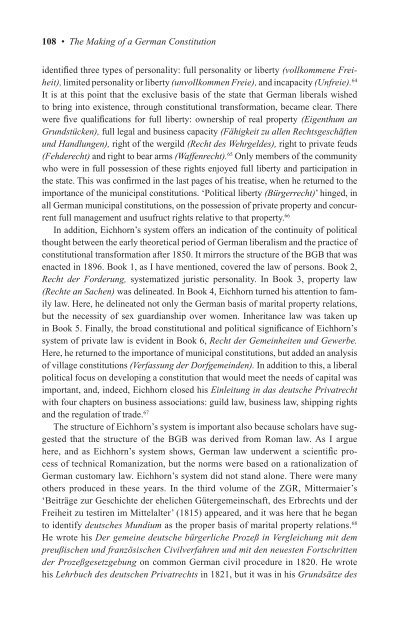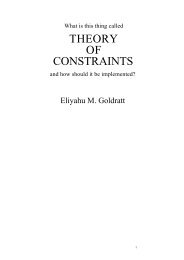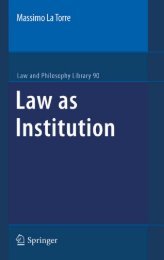Making of a German Constitution : a Slow Revolution
Making of a German Constitution : a Slow Revolution
Making of a German Constitution : a Slow Revolution
You also want an ePaper? Increase the reach of your titles
YUMPU automatically turns print PDFs into web optimized ePapers that Google loves.
108 • The <strong>Making</strong> <strong>of</strong> a <strong>German</strong> <strong>Constitution</strong>identified three types <strong>of</strong> personality: full personality or liberty (vollkommene Freiheit),limited personality or liberty (unvollkommen Freie), and incapacity (Unfreie). 64It is at this point that the exclusive basis <strong>of</strong> the state that <strong>German</strong> liberals wishedto bring into existence, through constitutional transformation, became clear. Therewere five qualifications for full liberty: ownership <strong>of</strong> real property (Eigenthum anGrundstücken), full legal and business capacity (Fähigkeit zu allen Rechtsgeschäftenund Handlungen), right <strong>of</strong> the wergild (Recht des Wehrgeldes), right to private feuds(Fehderecht) and right to bear arms (Waffenrecht). 65 Only members <strong>of</strong> the communitywho were in full possession <strong>of</strong> these rights enjoyed full liberty and participation inthe state. This was confirmed in the last pages <strong>of</strong> his treatise, when he returned to theimportance <strong>of</strong> the municipal constitutions. ‘Political liberty (Bürgerrecht)’ hinged, inall <strong>German</strong> municipal constitutions, on the possession <strong>of</strong> private property and concurrentfull management and usufruct rights relative to that property. 66In addition, Eichhorn’s system <strong>of</strong>fers an indication <strong>of</strong> the continuity <strong>of</strong> politicalthought between the early theoretical period <strong>of</strong> <strong>German</strong> liberalism and the practice <strong>of</strong>constitutional transformation after 1850. It mirrors the structure <strong>of</strong> the BGB that wasenacted in 1896. Book 1, as I have mentioned, covered the law <strong>of</strong> persons. Book 2,Recht der Forderung, systematized juristic personality. In Book 3, property law(Rechte an Sachen) was delineated. In Book 4, Eichhorn turned his attention to familylaw. Here, he delineated not only the <strong>German</strong> basis <strong>of</strong> marital property relations,but the necessity <strong>of</strong> sex guardianship over women. Inheritance law was taken upin Book 5. Finally, the broad constitutional and political significance <strong>of</strong> Eichhorn’ssystem <strong>of</strong> private law is evident in Book 6, Recht der Gemeinheiten und Gewerbe.Here, he returned to the importance <strong>of</strong> municipal constitutions, but added an analysis<strong>of</strong> village constitutions (Verfassung der Dorfgemeinden). In addition to this, a liberalpolitical focus on developing a constitution that would meet the needs <strong>of</strong> capital wasimportant, and, indeed, Eichhorn closed his Einleitung in das deutsche Privatrechtwith four chapters on business associations: guild law, business law, shipping rightsand the regulation <strong>of</strong> trade. 67The structure <strong>of</strong> Eichhorn’s system is important also because scholars have suggestedthat the structure <strong>of</strong> the BGB was derived from Roman law. As I arguehere, and as Eichhorn’s system shows, <strong>German</strong> law underwent a scientific process<strong>of</strong> technical Romanization, but the norms were based on a rationalization <strong>of</strong><strong>German</strong> customary law. Eichhorn’s system did not stand alone. There were manyothers produced in these years. In the third volume <strong>of</strong> the ZGR, Mittermaier’s‘Beiträge zur Geschichte der ehelichen Gütergemeinschaft, des Erbrechts und derFreiheit zu testiren im Mittelalter’ (1815) appeared, and it was here that he beganto identify deutsches Mundium as the proper basis <strong>of</strong> marital property relations. 68He wrote his Der gemeine deutsche bürgerliche Prozeß in Vergleichung mit dempreußischen und französischen Civilverfahren und mit den neuesten Fortschrittender Prozeßgesetzgebung on common <strong>German</strong> civil procedure in 1820. He wrotehis Lehrbuch des deutschen Privatrechts in 1821, but it was in his Grundsätze des




